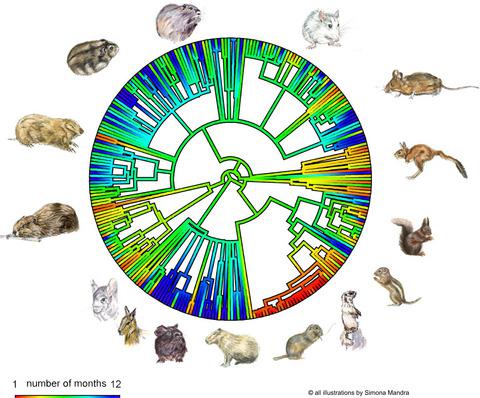当前位置:
X-MOL 学术
›
Mammal Rev.
›
论文详情
Our official English website, www.x-mol.net, welcomes your
feedback! (Note: you will need to create a separate account there.)
Latitude, life history and sexual size dimorphism correlate with reproductive seasonality in rodents
Mammal Review ( IF 4.3 ) Pub Date : 2021-01-10 , DOI: 10.1111/mam.12231 Sandra A. Heldstab 1, 2
中文翻译:

纬度,生活史和性大小二态性与啮齿动物的繁殖季节相关
更新日期:2021-03-15
Mammal Review ( IF 4.3 ) Pub Date : 2021-01-10 , DOI: 10.1111/mam.12231 Sandra A. Heldstab 1, 2
Affiliation

|
- Rodents show an immense variation in reproductive seasonality, spanning the whole spectrum from strictly seasonal to continuous reproduction throughout the year. However, the factors causing this variation have so far mostly been investigated in single‐species studies that could not address phylogenetic constraints.
- By applying both a categorical description and a quantitative measure, the present study characterises the degree of reproductive seasonality in the wild of 272 rodent species.
- Using a comparative approach, the relationships of 12 variables, comprising five life‐history variables, three abiotic variables, two niche variables and two allometric variables, with reproductive seasonality in rodents, were tested.
- The majority of rodents reproduced non‐seasonally and had particularly high intraspecific variation in reproductive seasonality compared to other mammalian groups. Their opportunistic breeding strategies, their large geographic ranges with wide latitude and elevation ranges, and their ability to live in human‐made environments may be related to this broad intraspecific variation of birth season length in rodents.
- The most important variables associated with rodent reproductive seasonality were mid‐latitude of the species’ geographical range, temperature, litters per year, weaning age, age at sexual maturity and sexual size dimorphism. Birth seasons become shorter with increasing latitude and colder temperatures, corresponding to the decreasing length of the favourable season. Species with more pronounced birth seasonality have fewer litters, which are weaned earlier and reach sexual maturity later, corresponding to the shorter period of optimal environmental conditions for reproduction. Sexual size dimorphism was weakly associated with birth seasonality, with more seasonal species having a higher degree of male‐biased sexual dimorphism, potentially because male–male competition and female monopolisation are more likely to evolve in species with short mating seasons.
- In conclusion, habitat seasonality and life‐history adaptations are most strongly associated with reproductive seasonality in rodents, which has important implications for zoo husbandry and for the effects of climate change on rodents.
中文翻译:

纬度,生活史和性大小二态性与啮齿动物的繁殖季节相关
- 啮齿动物的繁殖季节性变化很大,从严格的季节性变化到全年连续繁殖的整个范围。但是,到目前为止,导致这种差异的因素大部分是在无法解决系统发育限制的单物种研究中进行的。
- 通过应用分类描述和定量方法,本研究表征了272种啮齿动物物种在野生环境中的繁殖季节程度。
- 使用比较方法,测试了12个变量(包括5个生活史变量,3个非生物变量,2个利基变量和2个异体变量)与啮齿类动物繁殖季节之间的关系。
- 与其他哺乳动物群体相比,大多数啮齿动物非季节性繁殖,并且繁殖季节内种内变异特别高。它们的机会繁殖策略,较大的地理范围和较宽的纬度和海拔范围,以及它们在人为环境中生活的能力,可能与啮齿动物出生季节长度的种内广泛变化有关。
- 与啮齿动物生殖季节有关的最重要变量是该物种地理范围的中纬度,温度,每年的凋落物,断奶年龄,性成熟年龄和性大小二态性。出生季节随着纬度和低温的升高而变短,这与有利季节的长度减少相对应。出生季节更为明显的物种的凋落物较少,它们的断奶较早,而性成熟则较晚,这与繁殖的最佳环境条件的较短时期相对应。性大小二态性与出生季节的相关性较弱,更多的季节性物种具有较高的男性偏见性二态性,
- 总之,生境的季节性和生活史的适应性与啮齿动物的繁殖季节性最密切相关,这对动物园饲养和气候变化对啮齿动物的影响具有重要意义。











































 京公网安备 11010802027423号
京公网安备 11010802027423号